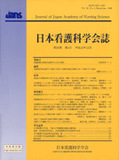Japanese
English
- 販売していません
- Abstract 文献概要
- 参考文献 Reference
- サイト内被引用 Cited by
要旨
本研究は,身体障害をもつ高齢者が老いと身体障害をもつことについていだく自己意識を明らかにし,介護老人保健施設入所中の高齢者9名に面接を行い,比較分析した結果を記述した.
身体障害をもつ高齢者の自己意識は7カテゴリーに分類された.高齢者は,【身体障害や老いることについての過去の意識】をもちながら,身体障害をもつという逃れられない現実を【「蜘蛛の巣」に絡まる身体】と意識し,施設で生活する自分を【籠の鳥】と意識していた.また,【支えてくれる家族と帰れる家】があることによって不安定な自己を支え,一方では帰る家がないことで生きる意味を見出せないでいた.さらに,高齢者は過去の自分との比較で【「輝いていた」ときと「輝かない」今】と意識し,他の高齢者との比較で【先行きは不安でも今の自分は幸せなほう】と意識していた.高齢者はこうした自己意識をいだきながら自らの【生と死】について考え,生きる意味を探していた.
この結果から,身体障害をもつ高齢者が自己実現を目指し前向きに老いを生きるためには,ケア提供者が高齢者にできる自分を意識させ,施設内の高齢者同士の関係性を築けるようにし,高齢者が自分の居場所を確保できるように援助する必要性が示唆された.
Abstract
The purpose of this study is to clarify how elderly disabled people are self-consciousness about aging and disability. I interviewed nine people living in a healthcare facility, collected the data and analyzed them by using comparative analysis.
The results show that their self-consciousness was categorized into seven types; they have “past consciousness about aging and disability”, and they feel like “their bodies get tangled up in the cobwebs”meaning they feel frustrated with their present physical and mental condition, and they are feeling like “a caged bird”meaning living in the facility. On the other hand, they feel at home with “their family which support them and they can go back to.”They also compare their present life with their past one, which they considered to be “a sparkling jewel in the crown.”Also, by comparing themselves with the other people in the facility they had “anxious thoughts about the future but feel better now.”All the while they think about “living and dying,” looking for the meaning of living their lives.
Because of this result I suggest through nursing practices that elderly disabled people may achieve self-realization and live positively if they can use their remaining abilities, form mutual relationships in the facility and try to make a comfortable place to live in.
Copyright © 2006, Japan Academy of Nursing Science. All rights reserved.


